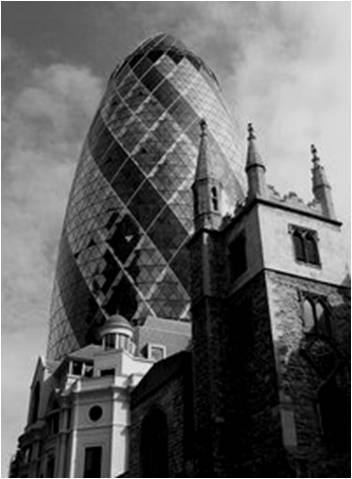
View of The Gherkin from outside
LOCATION:
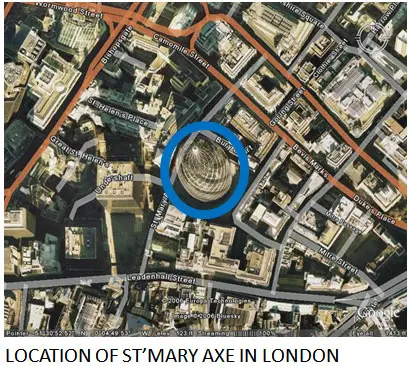
OTHER BUILDINGS IN THE SURROUNDING:
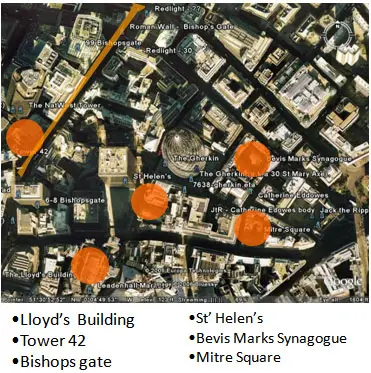
FACTS AND FIGURES DIMENSIONS:
- Height to top of dome: 179.8 m
- Height to highest occupied floor level: 167.1 m
- Number of floors above ground: 40
- Number of basement levels: single basement across whole site
- Largest floor external diameter (lvl 17): 56.15 m
- Site area: 0.57 hectares (1.4 acres)
- Net accommodations areas:
- Office 46,450 m2
- Retail 1,400 m2
- Office floor-floor: 4.15 m
- Gross superstructure floor area (incl. lightwells): 74,300 m2
- Tower Structural Steelwork
- Total weight of steel (from Arup Xsteel model): 8,358 tonnes of which:
- 29% is in the diagrid
- 24% core columns
- 47% beams
- Total number of primary steel pieces: 8 348
- Total length: 54.56 km
- Diagrid column sizes:
- Ground – level2: 508mm f, 40mm thick
- Level 36–38: 273mm f, 12.5mm thick
- Hoop design tension at level 2: 7 116 kN
- Perimeter column maximum design load: 15,460 kN
- Core column maximum design load: 33,266 kN
- Foundations 750mm diameter straight-shafted piles into London Clay
- Number of piles: 333
- Total length of piles: 9 km
- Total design capacity: 117,000 Tonnes
SECTIONAL ELEVATION:
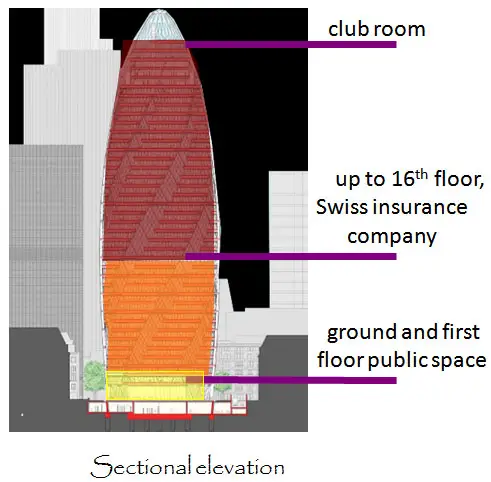
THE ARCHITECTURAL FORM:
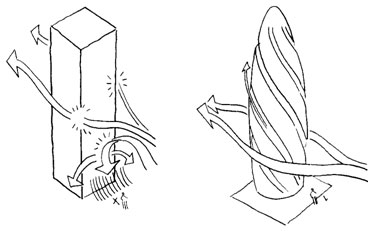
- The shape of the tower is influenced by the physical environment of the city.
- The smooth flow of wind around the building was one of the main considerations.
- A net office floor area within the building of around 500,000 ft2 (46,450 m2).
- The enhancement of the public environment at street level, opening up new views across the site to the frontages of the adjacent buildings and allowing good access to and around the new development.
- Minimum impact on the local wind environment.
- Maximum use of public transport for the occupants of the building.
- Flexibly serviced, high specification ‘user-friendly’ column free office spaces with maximum primary space adjacent to natural light.
- Good physical and visual interconnectivity between floors.
- Reduced energy consumption by use of natural ventilation whenever suitable, low façade heat gain and smart building control systems.
PLANS:
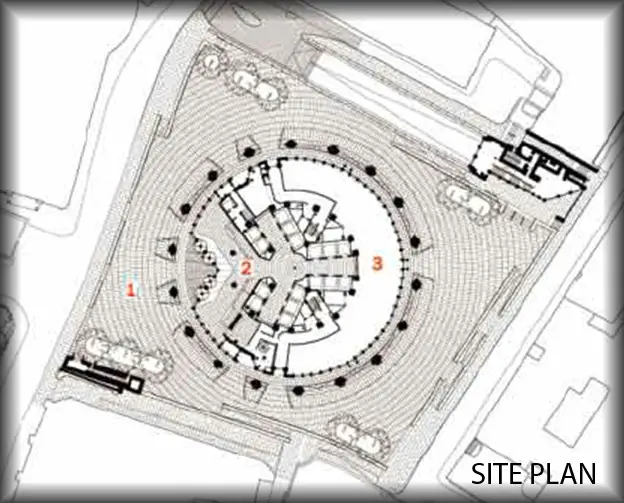
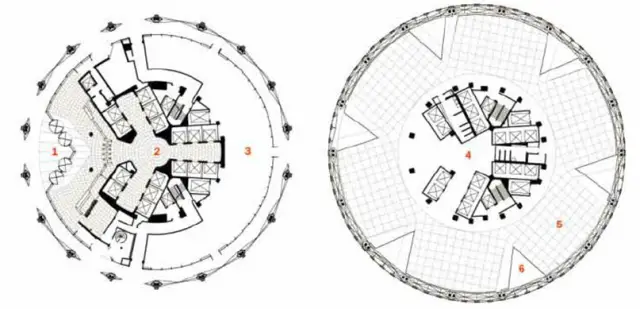
1. Ground Floor Plan 2. Sixth Floor Plan
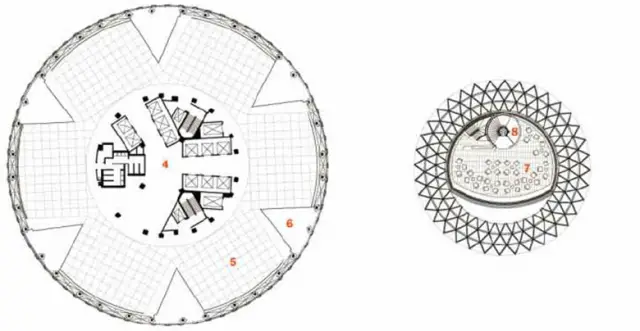
3. Twenty-First Floor Plan 4. Fortieth Floor Plan
- Entry
- Lobby
- Retail
- Core
- Office Modules
- Light Well
- Private Dining
- Elevator / Stair
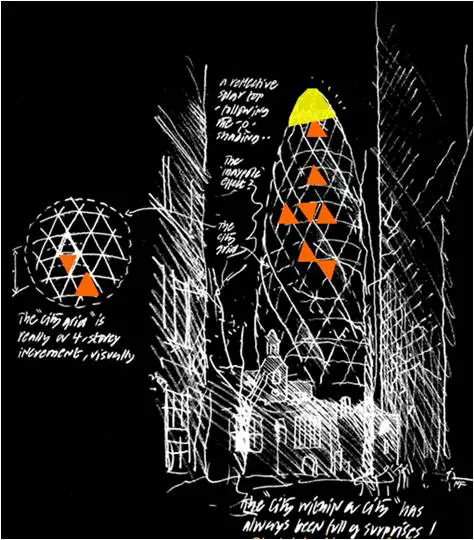
- 30 St Mary Axe has a radical approach – technically, architecturally, socially and spatially.
- Idea of having a city within a city.
- An instantly recognizable addition to the city’s Skyline.
SUSTAINABLE BUILDING:
- The tower is aerodynamically designed to reduce wind load on the structure, whilst the lower part tapers so that wind wraps around the tower.
- The six fingers of accommodation on each floor, configured with light wells in between, maximize daylight penetration.
- The façade design with advance glazing technologies, ventilated cavities and blinds , provides up to 85% solar protection.
- Gas is the main fuel used hence it will only generate half the carbon emission.
- Overall energy serving is up to 50%.
SOME BASIC FACTS:
- Single basement across whole site.
- 17th floor is having largest floor diameter of 56m.
- Each floor is rotated by 5 degree.
- 38th to 40th floor are having restaurants .
- At a time 4000 workers can be accommodated.
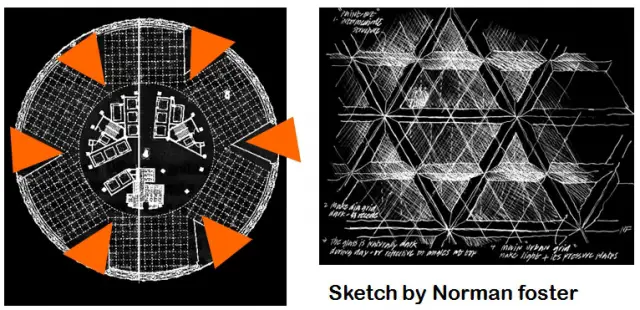
BUILDING IN RELATION TO ITS SURROUNDING:
- The building look like as if it is planted on the Street .
- The mass of the Swiss Re tower is not too imposing at ground level.
- Swiss Re sits nicely in narrow pedestrians street.
- At the pavement, it emerges from the diamond-pattern glass to create an arcade of shops at street level.
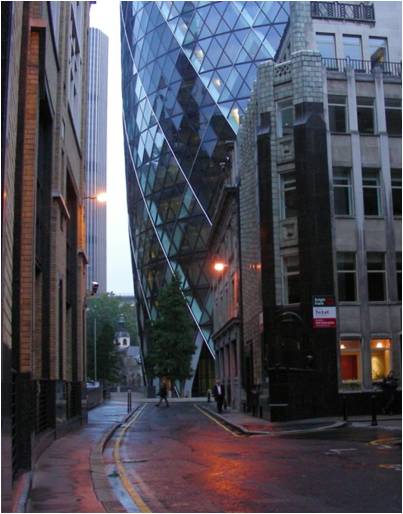
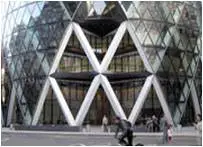
STRUCTURAL SYSTEM:
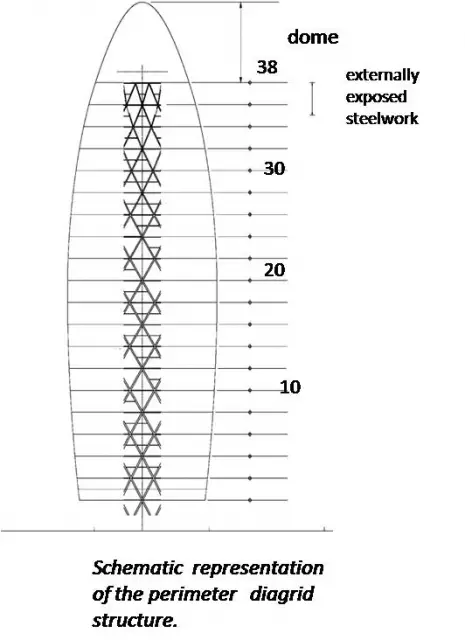
- The ‘diagrid’ responds to the building’s curved shape and provides vertical support to the floors thus allowing large internal column free office space.
- The central core is required only to act under vertical load and is free from diagonal bracing.
- In addition to being highly efficient in resisting wind forces, the ‘diagrid’ frames the communal light wells which spiral up the building enabling occupants to enjoy natural light over a larger area of floor.
- The internal structure of the building comprises conventional steel beams and columns with composite profiled decking floors.
- The total weight of steel used is approximately 11,000 tones.
- Arup’ engineers addressed the building’s radical form by creating the efficient external ‘diagrid’ system (diagonally braced structure) of intersecting steel sections around the tower’s perimeter.
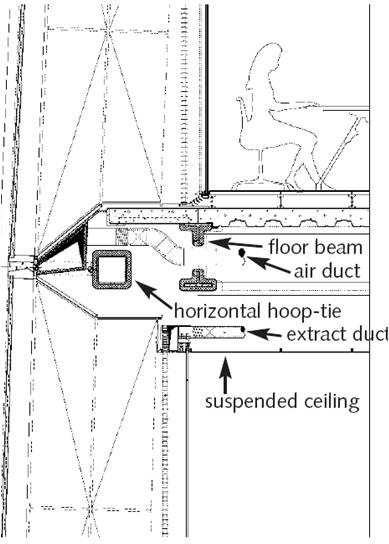
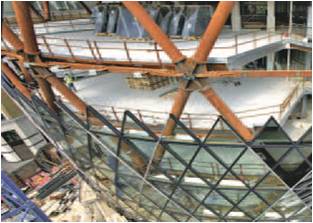
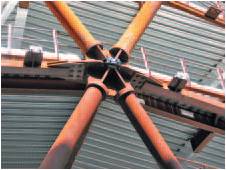
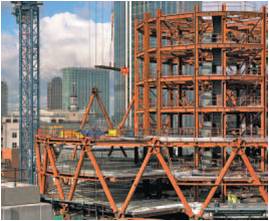
- The produced node is prefabricated in the factory.
- The heart consists of a solid block of steel of 240 by 140 mm.
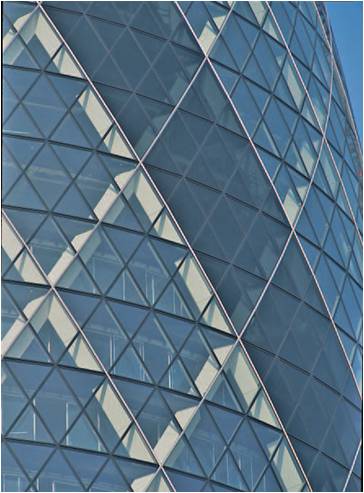
- The elements of the facade.
- Openable glass screen.
- Perforated aluminium louvers (internal sun-screen).
- A column casing of aluminium.
- Façade frame of extruded aluminium.
PARKING:
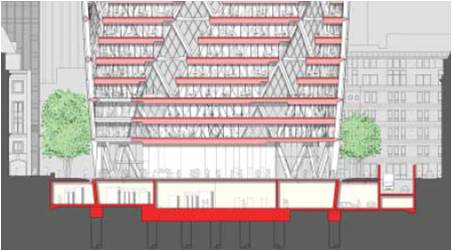
Sectional Elevation of Parking (Single Basement Parking)
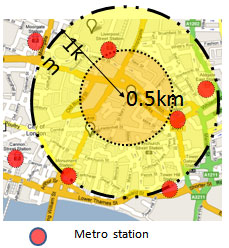
- Radical approach towards public transportation.
- Provided Parking space for bicycle is three times more than needed . No provision for private car parking.
LIFTS:
- There are 18 passenger lifts in the building.
- 378 people can be vertically transported through the building at speeds upto 6m per second at any time.
- In addition, there are goods and firefighter elevators, as well as a car park elevator to the reception from the basement.
- Two special shuttle elevators serve the top floors of the building.
- KONE Alta™ fulfilled the architects’ requirements for customized elevator cars and signalization.
- 3 different levels:
- Low rise go from lobby to level 12.
- Medium rise lifts go from lobby to 22 stopping from level 11.
- High rise lifts go from lobby to 34 stopping from level 22.
- Shuttle lift goes from level 34 to level 39.
FIRE FIGHTING METHODS:
- Swiss Re falls within the guidance of inner London Section 20 requirements for fire safety.
- Every sixth floor , the atria feature gardens which control and purify air movements as well as dividing the building into fire compartments.
- The unusual light well arrangement leads to a fire escape strategy based on a variation of phased evacuation.
- In this case all six floors linked by a set of light wells are evacuated in the case of a fire on any one of them.
- Where only two floors are linked then those two constitute the first phase. So the light wells are designed following the guidance for simultaneous evacuation, which allows them to be open to the accommodation.
- Because the lightwell base floors are protected by sprinklers on the overhanging soffits above, they can be used as office space too.
- A system of smoke curtains form smoke reservoirs in the light wells, and others delay the transport of smoke from accommodation into the light wells.
- Natural ventilation is used for smoke clearance for the light wells and the accommodation.
- The building is sprinkle red, including arrays of window sprinklers on part of the façade of levels 2 and 3, to protect a glazed opening in the compartment floor of level 4, directly above.
- However sprinklers have not been fitted in the 12m high domed space that forms the very top of the building.
- The Tower has two firefighting shafts with dedicated lifts.
- The use of dedicated smoke detectors in each lobby which cause the vent to open in that lobby, as well as at the top of the smoke shaft and the top of the stair.
- During a fire temperatures can be such that the window glazing may break and thus allow cool air to enter and hot gas to escape.
- Alternatively, temperatures may be such that the fire has not engulfed a large area and is not severe enough to actually break the glass.
- In both cases the temperature reached in the compartment and the duration of a fire is dependent on the amount of ventilation, and it is assumed that sprinkler activation has not prevented the fire from growing.
SERVICE CORE AREA:
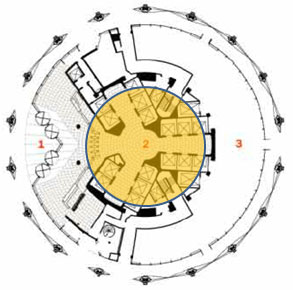
Core area at centre
INTERESTING FACTS:
- Swiss Re reserves the terraces in its light wells—and their dramatic views for functions that trigger idea sharing.
- Making other floors visible also breaks down physical barriers to collaboration.
- Ample daylight for offices comes both from the curve of the exterior and the wedge-shaped light wells.
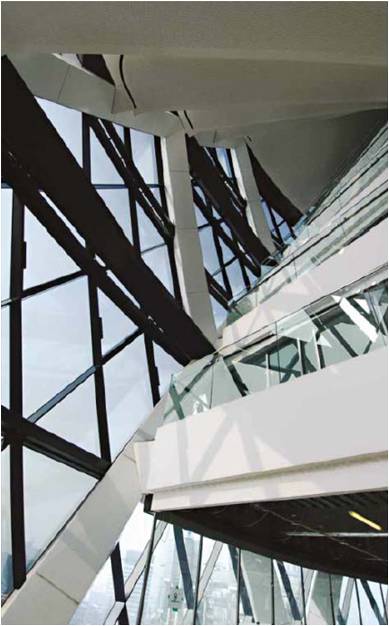
There are 24,000 sq m of external glass-equivalent to five football pitches.
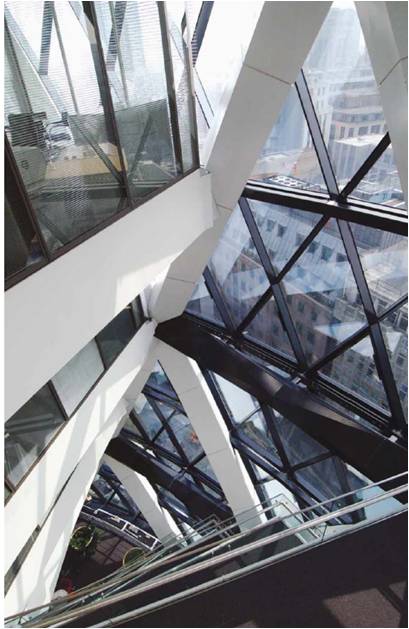
The white-painted diagonals and dark-painted horizontals both enclose structural members.
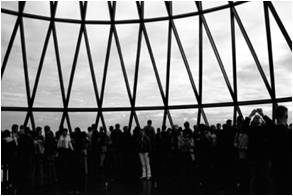
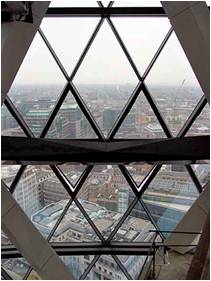
Top space of the building offers a spectacular 360-degree panorama across the capital.
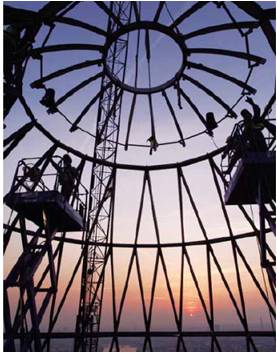
Despite its curved shape, there is actually only one piece of curved glass – the lens at the top of the building which is 2.4m in diameter and weighs 250kg.

this page has been very
this page has been very helpful!!! thanks to the one who posted it
Agreed !!! Thanks for info.
Agreed !!! Thanks for info. I’m done my homework 🙂
Very helpful!
Very helpful!
Thank you for the effort.
Thank you for the effort.
Thanks for the effort and God
Thanks for the effort and God bless you.
Excellent source of
Excellent source of information with exceptional detail and easy to understand for all
thank you so much for the
thank you so much for the article.
how about adding more info about some failure of the building?
😀
what great information thank
what great information thank you for the information. Even better than the architects website who designed it.
Awesome works a m a z i n g l
Awesome works a m a z i n g l y